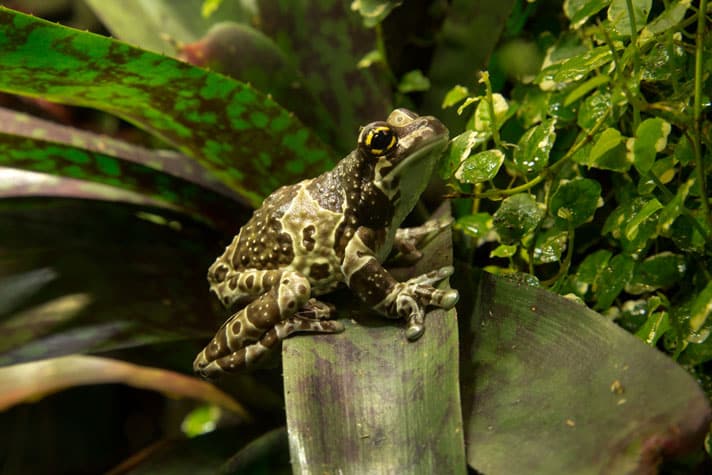Also known as the Amazonian milk frog or panda bear tree frog due to the contrasting black and white coloration of juveniles, Trachycephalus resinific
Also known as the Amazonian milk frog or panda bear tree frog due to the contrasting black and white coloration of juveniles, Trachycephalus resinifictrix is an enjoyable frog to keep. They are hardy, captive-bred stock is regularly available, and they have fascinating natural histories which revolve around tree holes in the canopy of the Amazon Rainforest. While not as common as the more familiar White’s tree frog (Litoria caerulea), their captive care is similar, and with a little amphibian husbandry experience you can keep milk frogs relatively simply. Though their care is uncomplicated, they are rewarding pet frogs and are especially enjoyable to watch at night while moving about their enclosure.
Milk Frog Size
Adult male milk frogs can reach 2.5 inches in length. Females are larger and can grow to 4 inches. They are large-bodied tree frogs, with big hands for climbing, large toe-pads, and an overall rotund appearance.
Milk Frog Life Span
Captive milk frogs have been known to live for 8 years or more. Providing a varied diet and optimal environmental conditions such as UVB lighting and the right temperatures will contribute to a long-lived captive frog.
Milk Frog Caging
A standard 20-gallon aquarium is large enough for one or two adult milk frogs while a larger enclosure that measures 24”L x 18”D x 24”H is big enough for a group of five. Juveniles should be housed in smaller enclosures such as 10-gallon aquariums so that they can be monitored more easily. Use a screen cover, such as the Zilla Fresh Air Screen Cover, to offer good ventilation.
A substrate of moist paper towels or sphagnum moss, such as the Zilla Fir & Sphagnum Peat Moss Mix Reptile Bedding can be used, although some people prefer to skip a substrate altogether and simply directly clean the bottom of the enclosure. Milk frogs are highly arboreal and in nature rarely if ever come down from their home in the trees which is why they require extra habitat and frog supplies. Provide perches above ground such as cork bark, bamboo poles, or sections of PVC pipe. Artificial plants or live plants can also be used. If using live plants, opt for sturdy varieties like large-leafed types of Philodendron or big Neoregelia sp. bromeliads.
In the wild, milk frogs breed in and spend much of their time around large water-filled tree holes. In captivity, a big water dish will serve this purpose. Change the water daily and only use tap water that has had chlorines or chloramines removed first. The entire enclosure should be cleaned every few weeks. Avoid using soaps or detergents when cleaning the cage and instead use hot water to help remove waste if necessary.
Milk Frog Temperature and Humidity
Allow an area of the enclosure to reach 80-85°F during the day, with other cooler parts of the enclosure staying around 70-75°F. At night the temperature can fall to 65°F. Incandescent light bulbs, such as the Exo Terra Night Heat Bulb Reptile Lamp, can be used for heating if needed. Make sure to use an accurate thermometer, such as the Zoo Med ReptiTemp Digital Infrared Thermometer, to measure the temperature.
Humidity levels of 50-100% are suitable. Mist the cage daily to provide temporary increases in humidity using a reptile mister. You can use dechlorinated tap water or reverse-osmosis (RO) water for misting.
Milk Frog Lighting
It is a good idea to provide UVB lighting for milk frogs in captivity with appropriate amphibian light fixtures. Use a UVB bulb with 2.0 or 5.0 strength and make sure it is positioned over a screen section of the cover, like Zoo Med’s Reptisun UVB Compact Fluorescent Bulb. This bulb must be replaced annually. In addition to a UVB light, you can also use another fluorescent light with a more natural color temperature of 5000-6500K so that the enclosure looks more natural.
Milk Frog Food
Feed milk frogs a variety of live invertebrates. Crickets can make up a large portion of the diet, with other foods like house flies, cockroaches, and earthworms being rotated into the diet regularly. Flightless fruit flies can also be fed to young frogs. Offer food to juveniles daily and adults only around two days per week, with 3-10 food items per frog each feeding.
It is important to use a high-quality vitamin and mineral supplement to help prevent nutritional problems. Use a supplement that is phosphorus-free and contains vitamin A and D3. Cover food in this supplement at every feeding for growing juveniles and every other feeding for adults.
Milk Frog Handling
Don’t handle milk frogs except when necessary, such as when removing frogs to clean the enclosure or examine their health. Like all amphibians, milk frogs have a permeable skin that is sensitive to the oils and salts naturally found in human skin. You can use powder-free disposable gloves for handling milk frogs when needed.
Milk Frog Behavior
Milk frogs are nocturnal animals and generally remain asleep during the day. They often will hide inside hollow cork bark tubes or other similar structures in captivity until night. At night they become active and this is the best time to observe them. Many milk frogs will also waken during the day after the terrarium is misted with water or if they are being fed.


